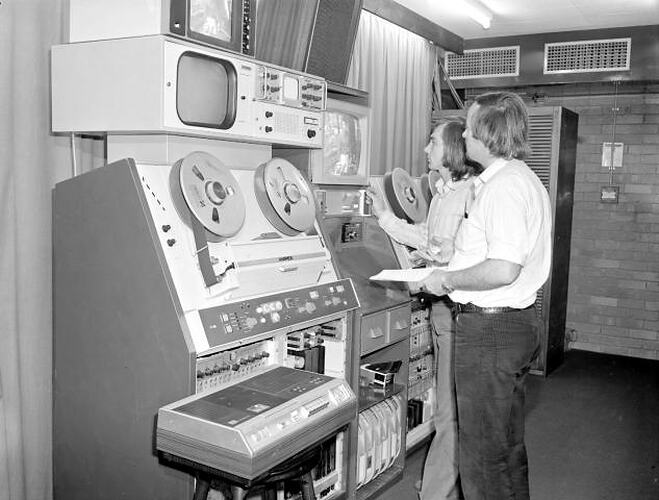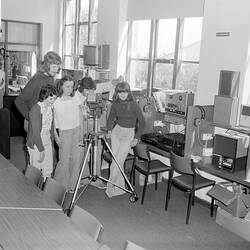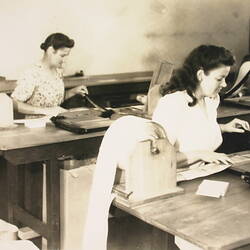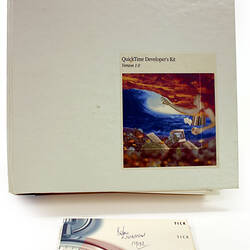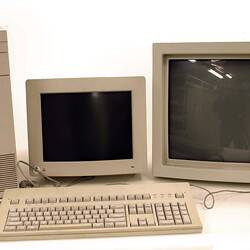The invention of video tape recording and lightweight video cameras soon resulted in the displacement of 8mm film as the primary means for amateurs to capture video. Editing video tape recordings was carried out physically and good results were difficult to achieve.
In 1989, in a major advance in the editing of videotapes, Avid Technology Inc introduced a digital non-linear editing system initially for use on the Macintosh II. (See below for an explanation of non-linear and linear editing)
Videos could be edited on disk as opposed to physically editing video tape or film. Analogue video to digital video conversion was expensive using the software, computer and plug-in printed circuit board. But it allowed high-end production houses to edit film or video more easily and non-destructively. Film was scanned and digitised, edited and then printed back to film.
The first feature film, edited using the Avid system, came out in 1994. It was called 'Let's Kill All the Lawyers'. In 1995, 'The English Patient' was edited using the Avid system, for which it was awarded the first editing Oscar for a digitally edited film.
In the meantime, in October 1991, Apple introduced the Macintosh Quadra 900. At the time of its release it was a state of the art computer with, for its time, a very fast 25MHz Motorola 68040 processor and a very large capacity to address up to 256MB of RAM.
Just two months later, on 2 December 1991, Apple released its QuickTime software. Among other capabilities, QuickTime supported the display of movies on screen, initially in a postage-stamp sized frame but later in full screen at 25 frames per second. The QuickTime software provided basic editing functions, such as cropping. Its file format functioned as a multimedia container for tracks to store video, audio, animation or text.
The Quadra 900 was one of the first computers that could be used to create and edit movies using QuickTime. This was achieved by plugging a printed circuit board, such as a VideoSpigot card, into the Quadra 900. This transferred data from the camera to the computer through a cable. The computer read and converted the camera's analogue video into digital video, compressed it and saved it to the hard disk in QuickTime (.mov) format.
The VideoSpigot needed software (ScreenPlay) installed in the Quadra to initiate and control the operation of the Videospigot card. The Quadra's support for a second monitor allowed multiple windows to be viewed whilst working in graphics or video.
Also in December 1991, Adobe released a fully professional digital non-linear editing program (see below) called Adobe Premiere. This allowed editing to be performed non-destructively, and special effects to be included, such as titling and transitions. The editing tools provided by Adobe Premiere were much more extensive than those provided by QuickTime. When editing was complete, the new video file could then be outputted to a video tape.
A modest Avid system in 1992 would have cost AUD$100,000 and with additional modules, AUD$150,000 or more, making it clearly the province of the high-end production house.
However, AUD$20,000 would have bought a Quadra 900 with a second monitor, VideoSpigot, CD-ROM reader, analogue video camera and Adobe Premiere. This brought video editing to a slightly broader group than high-end production houses.
Further advances followed in 1993, with the incorporation of analogue to digital capability into the Centris and Quadra AV series of Apple computers, though none of these machines had the RAM capacity of the Quadra 900. Subsequently digital video conversion capability was incorporated into the full range of Apple computers.
Then, in 1999, the relatively inexpensive iMac DV SE computer was released, costing US$1500. This greatly increased the number of video enthusiasts engaged in digital video production. The computer came with increased RAM, a FireWire port and the iMovie application. Importation of video footage was now carried out using the FireWire interface, which was to be found on most MiniDV format digital video cameras.
From then on, movie editing at home or school was accessible to the general public. Improvements in computer technology meant transitions that took hours to be processed on the Quadra 900 in 1991 could be rendered in minutes on a Mac.
Also in 1999, Apple introduced a fully professional video editing application, Final Cut Pro, a direct competitor on the Macintosh to Adobe Premiere. More importantly, it could to do work that previously required access to an expensive Avid studio. Initially it came bundled with the FireWire-enabled Power Mac G3. Final Cut Pro gradually became established as an essential tool for editors. It came into direct competition with Avid, forcing the one-time leader in non-linear editing to dramatically lower its prices.
From 2001, Apple's iDVD was also bundled with the computer and this software enabled the edited movie to be burnt straight to a DVD complete with menus and titles without resorting to a third-party application. In 2005, Apple released iMovie HD which supported the newly introduced high-definition video format HDV.
Non-linear editing is a non-destructive editing process
In video editing, the terms 'linear video editing' and 'non-linear video editing' have technical meanings, which can be explained as follows:
Linear video editing describes a process in which scenes are copied from one video tape to another, using two tape VCRs, in the order required. The new tape is thus created in a linear fashion. The disadvantage of this method is that it is not possible to insert or delete scenes from the new tape without re-copying all the subsequent scenes. Linear editing was the method originally used with analogue video tapes.
Non-linear video editing is achieved by loading the video material into a computer from analogue or digital tape. The editing process creates a new 'tape' by storing all the commands entered by the operator. This method allows the operator to cut, copy and paste scenes in any order and make any changes desired. At the completion of the editing process the computer can then build a new file by applying the commands to the original digital image stored on the disk. The original digital image on the disk is unchanged. The new video file can then be outputted to a video tape, attached to an email or posted to the web.
References:
http://en.wikipedia.org/wiki/Avid, viewed 16/02/2009.
More Information
-
Keywords
-
Authors
Mr Noel S. Jackling, Mr Stephen Withers, Mr Brian R. Livingston
-
Article types
